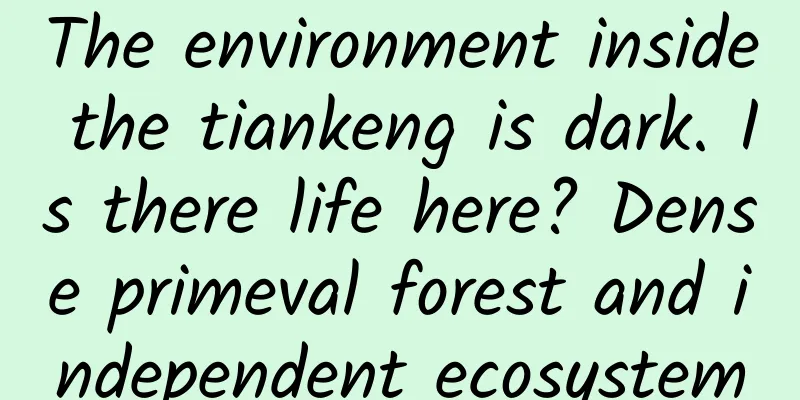The environment inside the tiankeng is dark. Is there life here? Dense primeval forest and independent ecosystem

|
On the surface, it is difficult to find a corner that is not occupied by life. Even in a sinkhole hundreds of meters deep, there is still an independent paradise of life. Tiankeng, in geography, should be called "karst funnel". As the name suggests, it is inextricably linked to "karst landform". A long time ago, humans came to the Karst Plateau in Slovenia, where they discovered a highly recognizable landform feature with a rugged surface and thousands of gullies, so they named the landform with this feature "karst landform". The formation of karst landform is simply the result of the interaction between soluble rocks and water. Under the impact and erosion of water flow, soluble rocks become more and more loose over time, and then collapse and sediment under the action of gravity, and thus karst landform is born. Karst landform is a general term. Specifically, its characteristics can be divided into stone buds, karst gullies, peak clusters, peak forests, isolated peaks and karst funnels, etc. Among them, the karst funnel is what we commonly call "sinkhole". There are quite a few tiankengs in the world. There are as many as 30 in Leye County of Guangxi, my country alone. However, there are seven most famous tiankengs in the world, four of which are in my country, namely Xiaozhai Tiankeng, Dashiwei, Xiaoyanwan Dafunnel and Yunyang Longgang. Since they can become "world famous", they must be very spectacular. Take the "Dashiwei" in Leye County for example. Its vertical depth reaches 613 meters and its total internal capacity exceeds 40 million cubic meters. The huge pit is more than 600 meters deep. Even if you have never seen it with your own eyes, you can imagine how dark it is inside, a terrifying darkness. So what is inside the tiankeng? Judging from common sense, the tiankeng should be dead silent, because not much light can reach here. Without light, how can plants perform photosynthesis? Without plants, animals would have no basis for existence. But in fact, this is not the case. There is not only life in the tiankeng, but also extremely prosperous. Many tiankengs have dense primeval forests, and have formed their own independent ecosystems. It is not an exaggeration to call the dense forests in the tiankeng "primeval forests", because people have found many rare plants represented by short-bowel ferns in the tiankeng. Some plants are even left over from millions of years ago. These plants are almost difficult to see on the surface. How did a dense forest form in the dark sinkhole? Plants need three basic conditions to grow: sunlight, water, and nutrients. Plants need to rely on photosynthesis to grow, but they do not necessarily need direct sunlight. Although the sinkhole is dark, it is not pitch dark. Light can still flow in through reflection and scattering, and some parts of the sinkhole can even receive direct sunlight. Therefore, the distribution of plants in the sinkhole has obvious block characteristics. Some light-loving plants will grow in places that can receive direct sunlight, while shade-loving plants will grow in some relatively dark corners. For these shade-loving plants, a little light is enough to support their growth. The water source in the tiankeng is even less of a problem. A tiankeng is a karst funnel, and the formation of karst landforms is the result of the interaction between soluble rocks and water. Before a tiankeng is formed, an underground river is a necessary condition. It is because of the long-term scouring of the underground river that the underground is hollowed out, and then the upper rock collapses to form a tiankeng. Therefore, there must be abundant groundwater under the surface of the tiankeng, so plants have a basis for growth. So what about nutrients? Nutrients are not a problem. What else can be richer than the minerals in limestone? In particular, potassium, which is indispensable for plant growth, is not lacking here. Sunlight, water and nutrients, the three basic conditions are all there, and two of them are very abundant, so the primeval forest in the tiankeng can naturally grow very dense. There are plants in the tiankeng, so are there animals? Of course, in the previous exploration of the "Dashiwei" in Leye County, scientists found traces of python movement, which is not a simple discovery. Pythons are not herbivores. If they are regarded as the top of the food chain in the tiankeng, it means that there is a complete food chain in the tiankeng, and an independent ecosystem has been formed. Compared with the "Dashiwei" in Leye County, the Xiaozhai tiankeng is even more powerful, because it is not only deeper than the Dashiwei, but also has many underground rivers inside, so scientists speculate that there may even be a natural underground palace under the Xiaozhai tiankeng. The tiankeng seems to be a mysterious underground world, but it is not a real underground world. It is still above the surface, and all human activities are limited to the thinnest outer shell of the earth-above the crust. No one has ever seen the real underground world. For more information, please follow the official account: sunmonarch |
<<: Be careful of waist aging before aging! These postures are the most harmful to waist...
>>: What is legitimate defense? How can we act bravely?
Recommend
[Smart Farmers] Necrosis, deformity, slow growth, how to prevent and control plant viruses?
Plant viruses are a double-edged sword The Nether...
Learn how to use the AARRR model to achieve user growth in one article
" User growth is essentially a precise, low-...
Google recruitment information leaked: Android Studio can be used to develop Android systems
Google recently released a new job posting on its...
Why are Western countries so concerned about facial recognition technology?
Facial recognition technology is now prevalent in...
Today in Science and Technology History | March 20, 1800 Scientist Volta invented the first battery in human history
One of the qualities of a great scientist is his ...
Snatching food from the tiger's mouth: the story of WeChat phone book and operators
[[122899]] In the past two days, my friend circle...
Detailed explanation of Win10's new game mode: How much can it improve gaming?
Everyone says that Windows 10 will be the "l...
4K becomes the standard for TVs, but there are differences in standard names
4K TV is a TV with a physical screen resolution o...
iOS front-end compiler extension - Clang
Part 01: Understanding Clang As we all know, comp...
Some people wear mink wraps, some wear short sleeves. How should we dress correctly in this national “random dressing season”?
The winter chill gradually fades away, and in ear...
January 2024 "Science" Rumors List: Will coughing for a long time lead to pneumonia? Will hot springs infect you with HPV?
The list of "scientific" rumors for Jan...
Google is fixing an issue with Android's WebView component causing app crashes
[[389179]] Recently, many users have complained o...
Which type of promotion is more effective: paid promotion, free promotion, or social media promotion?
When farming on the Internet, traffic is like the...
How much does Douyin merchant certification cost? How much does Douyin enterprise certification cost?
How much does Douyin merchant certification cost?...
Self-driving cars will make this billion-dollar market extinct
According to foreign media reports, in an intervi...









